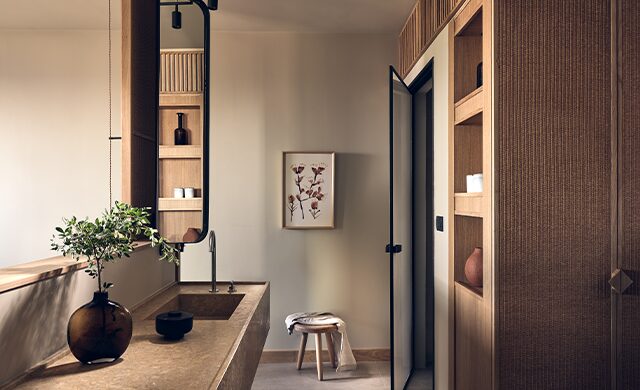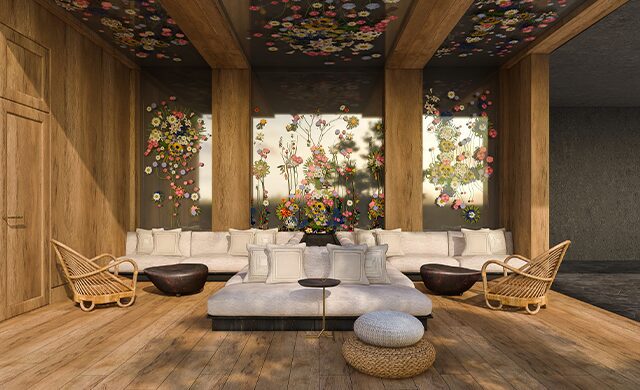Bold hospitality requires pioneers. Meet nine designers who took a leap of faith from senior positions in globally celebrated studios to launch their own progressive practices.
RoseBernard Studio
San Francisco
A phoenix from the ashes story of sorts, RoseBernard Studio was founded in San Francisco by Puccini Group alumni Robert Polacek and Justin Colombik following the firm’s shuttering in 2019 after its namesake Bob Puccini’s sudden passing. Deciding that a combination of their own names felt disconnected from the narrative they wanted to craft, the duo settled on a moniker that references Colombik’s artist and model grandmother and Polacek’s master carpenter and chef grandfather.
“Ultimately, what we do is not about us,” says Polacek. “It’s about stories.” Indeed, storytelling is at the heart of every project. At Quail & Crane restaurant at the Grand Hyatt at SFO in San Francisco, for instance, the firm embraced a restrained yet playful aesthetic—helping to rethink what an airport hotel should be. Further, the studio’s rapidly expanding pipeline counts a new-build Kempinski hotel in Kuala Lumpur, where they will be responsible for four F&B spaces, including the highest outdoor bar in the city.

A rendering of the pastry café in the upcoming Kempinski Kuala Lumpur
“Our own individual narratives can be found woven beautifully together in each project,” notes Colombik, who says he prefers bold, cleaned-up architectural lines, while Polacek is drawn to a more organic and layered style. “Our aesthetics are meaningful reflections of our own perspectives,” and by fostering these differences, the pair is able to create a compelling story for clients, he says.
Both Polacek and Colombik acknowledge how their time at Puccini Group continues to influence RoseBernard’s trajectory. “The most important aspect that we wanted to honor and develop is nurturing an open studio environment,” Colombik says. “The creativity of our team is our first priority.”
Looking ahead, RoseBernard’s multidisciplinary nature will manifest in strands that reach beyond interiors, with the introduction of a furniture line and in-house purchasing. “Design is our passion, and we want to apply that in other aspects—responding to the needs of our clients and helping them tell their stories through a creative lens,” Polacek says.
Studio Lost
London

Studio Lost, and the ideas behind it, have “long been in the making,” explains founder and creative director Constantina Tsoutsikou. The London-based Tsoutsikou oversaw an office of 25 designers in her role as creative director for HBA. After spending more than 14 years with the firm, the decision to depart late last year was not easy, but one that was creatively necessary.
“I have always been interested in the crossover between design, architecture, art, fashion, and culture,” she explains. “Working in luxury hotel design across the world gave me the opportunity to witness many interesting collaborations, and I’ve long been an admirer of entrepreneurs. Ultimately, it’s the crossover and fertilization of ideas between creative minds that excites me.”

The Royal Senses Resort & Spa in Crete showcases a residential-style layout
Still in relative infancy, Studio Lost is a particularly contemporary practice—one that blurs the lines between industries and is, in many ways, as much a brand as a service provider.
“I think of us more as a label than a studio,” says Tsoutsikou. “We capitalize on every creative window that a project gives us with grand visions that go beyond the brief to make spaces experiential vehicles. We aim to carve opportunities to work with artists, artisans, and craftspeople, alongside the usual ecosystem of hoteliers, contractors, suppliers, and engineers.”
Current projects include a luxury residential development in Moscow comprising three 60-story skyscrapers for which Studio Lost is designing lounges, concierge areas, and leather-clad mailrooms; an inventive aparthotel; and the Royal Senses Resort & Spa in Crete, Greece set to open this summer. “From here, our goal isn’t to get from A to B,” she says, “but to navigate to an unknown destination because that is where innovation lies.”
Studio Paolo Ferrari
Toronto

When Toronto-based Paolo Ferrari founded his namesake studio in 2016, it was, he says, a leap of faith. Though he had no specific projects lined up yet, having spent 12 years at Yabu Pushelberg leading large-scale works internationally, he finally felt ready to go out on his own.
“I had a vision of establishing a highly creative, multidisciplinary practice and this has guided how we’ve grown,” he explains of his studio, which is currently working with Frank Gehry on a Toronto residential tower and has recently completed the Secret Room, a surrealist nightclub in Dubai. Inspired by his Italian upbringing, he draws from the likes of Gio Ponti and John Lautner, figures celebrated for their timelessness and precision.

A luxe arrival lobby for a global luxury hotel brand flagship, shown in a rendering
“Most of our work is focused on the luxury sector,” Ferrari explains, “and it’s an extremely exciting time when design is genuinely democratized. Through our process, our goal is always to strive for powerfully iconic designs, anchored by strong interior architecture and highly refined furnishings.”
While at Yabu Pushelberg, Ferrari worked with powerhouse brands like Four Seasons Hotels and Resorts, Viceroy Hotel Group, and LVMH, and it’s that same sense of polish, detail, and focus that continues in his studio’s work.
“The experience gave us the confidence to pursue work with some of the world’s top brands, and we didn’t fall prey to the assumption that a smaller practice should be pursuing smaller projects,” he says.
Atelier Cho Thompson
New Haven, Connecticut and San Francisco

Ming Thompson and Christina Cho launched Atelier Cho Thompson in 2014 because they “both chafed against the boundaries of architecture,” says Thompson, who is now based in New Haven, Connecticut with Cho in San Francisco.
The duo met at Harvard and worked together at San Francisco firm Bohlin Cywinski Jackson for three years, where they learned how to design “modern buildings with a sensitivity to the way people use space and experience materials,” Thompson says. Their firm approaches projects via a similar holistic lens. Early on, they focused on startups that were seeking “a nimble firm to [help with architecture and branding] in a cohesive, streamlined manner,” says Cho. “We saw a need in the market and took the leap of faith to start a firm that could serve that need.”
Today, the studio is focused on developing projects that respond to our uncertain times. “The COVID-19 crisis has upended our world, and it’s time for architects to step up and create innovative solutions that can help our communities, particularly Black and Brown communities that are facing disproportionate impact,” says Thompson.

B-Natural Kitchen in New Haven, Connecticut employs plywood in uncommon ways
To that end, they’re working with an assisted living facility to design safe gathering spaces; a memorial for the City of New Haven, created with design students, that looks at the impact of the pandemic through a lens of justice; and a longterm project reimagining San Francisco public school cafeterias to “bring dignity, beautiful design, and messaging around inclusion to students throughout the district,” says Thompson. Outside of the office, they’re advocating for a more equitable profession that includes and promotes more women and people of color.
“A business partnership is more complex than marriage,” Thompson points out, but they have made it work. “Ming and I have worked together for so long,” adds Cho, “that we can speak in half sentences and still read each other’s minds.”
11fiftynine
Atlanta

Katie Sargent, Meg Jackson, and Betsy Hughes of 11fiftynine
Betsy Hughes and Katie Sargent met while they were both working at HBA in Atlanta, igniting a fruitful creative partnership that led to the founding of 11fiftynine almost two years ago. “We are the best versions of ourselves when we play off each other and think things through with our very different brain powers,” Hughes says.
Hughes credits three interiors jobs with teaching her how to build her own firm. The Gettys Group in Chicago coached her on the business side of design (“I was drinking it all in,” she says), while Jim Looney at Dallas’ Looney & Associates imparted on her the power of diplomacy and listening. When she landed at HBA in her native Atlanta, she saw how liberating creativity could be. “I thought, if I could package all these skills together, I could do this on my own.”
Sargent, meanwhile, was stealing her mom’s Architectural Digest magazines when she was 10 and drawing house plans for fun on the weekend. Her first foray into hospitality was converting a 10th-century castle in Tuscany into a luxury resort when she worked at JBanks Design Group in Savannah, Georgia. “I fell completely and madly in love with hotels, and it never left me after that,” she says.

Designed with HBA, a rendering of the spa reception at MNC Bali
The Atlanta-based 11fiftynine specializes in projects with tight timelines, with Hughes acting as managing director and Sargent as creative director. Meg Jackson, also an HBA alum, rounds out the three-member team as studio director. “A huge part of our promise to clients is an ability to stick to their schedule, budget, and operational requirements,” Sargent says. “Sometimes we get to start at step one, and sometimes we are jumping in at the eleventh hour to help someone to the finish line,” whether that’s installing more than 300 crystal decanters behind a bar or putting the final touches on a restaurant until 4 a.m. right before it opens.
“There’s something charming [about our projects],” Hughes says, which so far include the Turnberry in Scotland, two resorts in Indonesia, and one still-to-come project on the Jersey Shore. “[But] we are not Cinderella—we are the dress-sewing mice.” Adds Sargent: “We’ve hauled garbage, moved furniture, assembled chandeliers, made beds, and steamed drapery. We are efficient, so late nights are a rarity, but when a project is down to the wire, the motto is ‘whatever it takes.’”
Photos and renderings courtesy of Patricia Chang, RoseBernard Studio, Studio Lost, Studio Paolo Ferrari, Alicia Cho, Nicole Franzen, Samara Vise, 11fiftynine, and HBA
This article originally appeared in HD’s July 2020 issue.


